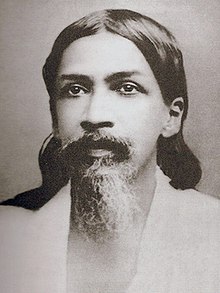
Back Aurobindo Ghose ALS سري أوروبندو Arabic سرى اوروبندو ARZ Sri Aurobindo AST Sri Aurobindo Azerbaijani Шри Ауробиндо Bashkir Шры Аўрабінда Byelorussian Шри Ауробиндо Bulgarian অরবিন্দ ঘোষ Bengali/Bangla Sri Aurobindo Catalan
Sri Aurobindo | |
|---|---|
 Aurobindo, c. 1900 | |
| Personal | |
| Born | Aurobindo Ghose 15 August 1872 |
| Died | 5 December 1950 (aged 78) |
| Religion | Hindu |
| Nationality | Indian |
| Alma mater | University of Cambridge |
| Relatives | Rajnarayan Basu (maternal-grandfather) Manmohan Ghose (brother) Barindra Kumar Ghose (brother)[1] |
| Signature | |
| Organization | |
| Founder of | Sri Aurobindo Ashram |
| Philosophy | |
| Senior posting | |
| Literary works | The Life Divine, The Synthesis of Yoga, Savitri |
The Spirit shall look out through Matter's gaze / And Matter shall reveal the Spirit's face.[2]
| Sri Aurobindo |
|---|
 |
| Part of a series on | |
| Hindu philosophy | |
|---|---|
 | |
| Orthodox | |
|
|
|
| Heterodox | |
|
|
|
Sri Aurobindo (born Aurobindo Ghose; 15 August 1872 – 5 December 1950) was an Indian philosopher, yogi, maharishi, poet, and Indian nationalist.[3] He was also a journalist, editing newspapers such as Bande Mataram.[4] He joined the Indian movement for independence from British colonial rule, until 1910 was one of its influential leaders, and then became a spiritual reformer, introducing his visions on human progress and spiritual evolution.
Aurobindo studied for the Indian Civil Service at King's College, in Cambridge, England. After returning to India he took up various civil service works under the Maharaja of the princely state of Baroda and became increasingly involved in nationalist politics in the Indian National Congress and the nascent revolutionary movement in Bengal with the Anushilan Samiti. He was arrested in the aftermath of a number of bombings linked to his organization in a public trial where he faced charges of treason for Alipore Conspiracy. However, Sri Aurobindo could only be convicted and imprisoned for writing articles against British colonial rule in India. He was released when no evidence could be provided, following the murder of a prosecution witness, Narendranath Goswami, during the trial. During his stay in the jail, he had mystical and spiritual experiences, after which he moved to Pondicherry, leaving politics for spiritual work.
At Pondicherry, Sri Aurobindo developed a spiritual practice he called Integral Yoga. The central theme of his vision was the evolution of human life into a divine life in a divine body. He believed in a spiritual realisation that not only liberated but transformed human nature, enabling a divine life on earth. In 1926, with the help of his spiritual collaborator, Mirra Alfassa (referred to as "The Mother"), Sri Aurobindo Ashram was founded.
Sri Aurobindo was nominated twice for the Nobel prize without it being awarded, in 1943 for the Nobel award in Literature and in 1950 for the Nobel award in Peace.
His main literary works are The Life Divine, which deals with the philosophical aspect of Integral Yoga;[5] Synthesis of Yoga, which deals with the principles and methods of Integral Yoga;[6] and Savitri: A Legend and a Symbol, an epic poem.
- ^ Dasgupta, Sanjukta. "A horrendous tale". www.thestatesman.com. The Statesman. Archived from the original on 18 January 2022. Retrieved 18 January 2022.
- ^ Savitri: A Legend and a Symbol, Book XI: The Book of Everlasting Day, Canto I: The Eternal Day: The Soul's Choice and The Supreme Consummation, p 709
- ^ Chaama, Sridhar (16 August 2012). "Remembering a guru". The Hindu. Archived from the original on 16 August 2021. Retrieved 17 August 2021.
- ^ McDermott (1994), pp. 11–12, 14
- ^ Sri Aurobindo, Sri (May 2009). The Life Divine. Sri Aurobindo Ashram Publication Department. ISBN 9788170588443. Archived from the original on 5 February 2024. Retrieved 19 June 2021.
- ^ Sri Aurobindo, Sri (1992). The Synthesis of Yoga. Lotus Press. ISBN 9780941524667. Archived from the original on 5 February 2024. Retrieved 19 June 2021.
© MMXXIII Rich X Search. We shall prevail. All rights reserved. Rich X Search